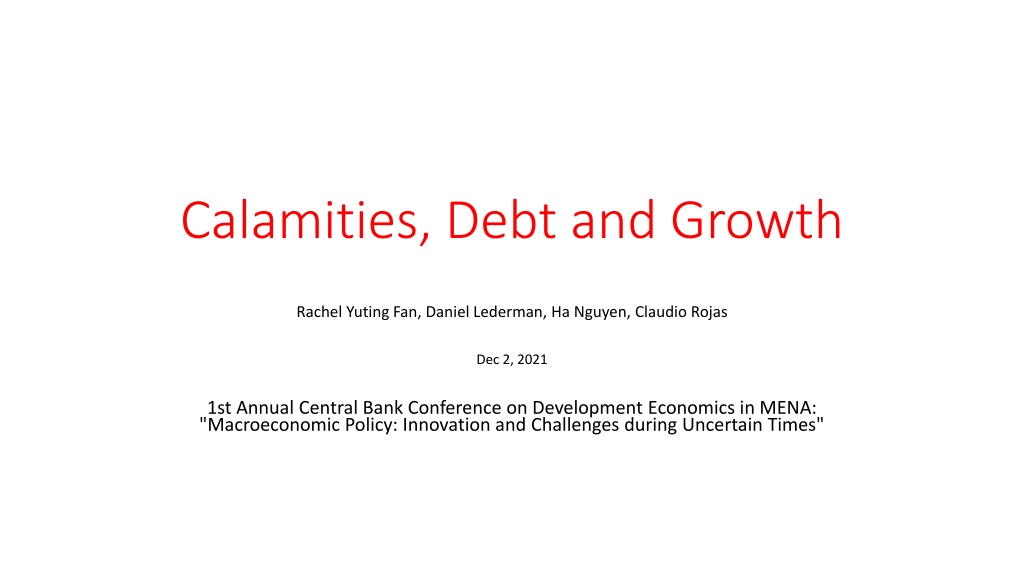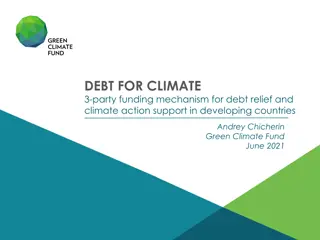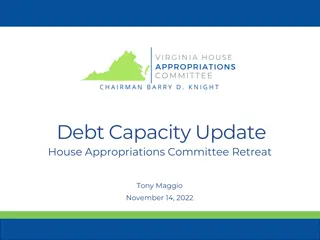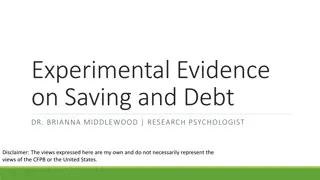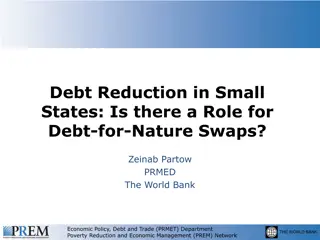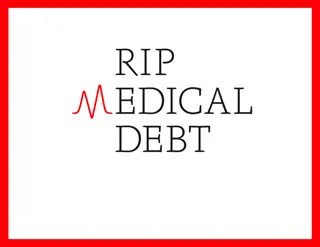Understanding Public Debt and Economic Growth in Developing Countries Amid Calamities
This paper explores the relationship between public debt, economic growth, and calamities like natural disasters, conflicts, and external debt distress in developing countries. Findings show that public debt tends to rise for economic recovery post-disasters, with growth accelerating beyond initial contractions. However, armed conflicts result in increased debt without corresponding growth, and highly indebted countries face challenges during debt distress episodes.
Download Presentation

Please find below an Image/Link to download the presentation.
The content on the website is provided AS IS for your information and personal use only. It may not be sold, licensed, or shared on other websites without obtaining consent from the author. Download presentation by click this link. If you encounter any issues during the download, it is possible that the publisher has removed the file from their server.
E N D
Presentation Transcript
Calamities, Debt and Growth Rachel Yuting Fan, Daniel Lederman, Ha Nguyen, Claudio Rojas Dec 2, 2021 1st Annual Central Bank Conference on Development Economics in MENA: "Macroeconomic Policy: Innovation and Challenges during Uncertain Times"
Motivation Countries are building up debt to make up for the collapse in revenue and respond to the pandemic Global average general government debt rose from 84 percent of GDP in 2019 to 99 percent in 2020. In emerging market economies, average general government debt rose from 52 of GDP in 2019 to 64 percent in 2020 (IMF, 2021). Developing countries face more severe tensions between the short-run gains and the potential long-run costs of debt-financed public spending. Therefore, this pandemic calamity raises the importance of understanding how public debt and growth evolve around calamities in developing countries. This paper examines how debt and economic growth evolve before, during, and after the onset of three important types of calamities, namely natural disasters, conflicts, and external debt distress, in developing countries.
Motivation Our paper is relevant to the Covid-19 pandemic because it examines and differentiates the evolution of debt and growth around three types of calamities. The Covid-19 pandemic shares many traits with natural disasters in fundamental ways relevant to understanding analytically how public debt and economic growth interact. Both pandemic and natural disasters are rare and unexpected occurrences, and neither are directly caused by economic policies. Both result in economic contractions because people cannot work (due to physical destruction or safety concerns). Therefore, examining debt and output growth around natural disasters could help policymakers and economists understand how debt-financed fiscal expenditures can help the recovery from the pandemic.
Main findings In developing countries, public debt tends to rise to finance economic recovery during and after large natural disasters. During the three years following a large natural disaster, growth in public debt is significantly higher than in countries that did not experience a disaster. Real GDP growth collapses in the year of a natural disaster but, after that, picks up faster than growth in no-disaster countries. These two findings provide an important empirical regularity that public debt does accumulate after disasters and is likely to do so after this pandemic, possibly to support economic recovery. The evolution of debt and growth is different around armed conflicts. Public debt increases during armed conflicts. Economic growth does not pick up after them, suggesting that government spending during conflicts might not be used to support economic growth. Highly indebted developing countries experience lower growth during debt distress episodes
Data Data on natural disasters are from the International Disaster Database (EM-DAT). Disaster: 10 or more people dead, or 100 or more people affected, a declaration of a state of emergency, or a call for international assistance. Between 1900 and 2020, the world has had 15,563 natural disasters, of which 1,492 were epidemics. To filter events with large macroeconomic effects, our econometric analysis focuses on natural disasters that generated damages equivalent to at least 1 percent of the country's GDP that year. The final sample covers 282 severe natural disasters that occurred between 1960 and 2019 in 86 developing countries. They include floods, earthquakes, droughts, storms, landslides, volcanic activity, extreme temperature, and wildfire. Data on arm conflicts are UCDP/PRIO Armed Conflict (version 20.1) that covers conflicts between 1963 to 2019. The sample covers 107 armed conflicts that occurred between 1963 and 2019 in 61 developing countries. Data on debt restructurings are based on Asonuma and Trebesch (2016), which provide information on the occurrence and duration of 204 restructurings globally starting in 1978, 197 of which have been completed.
Specifications ??,?= ?0+ ?+ ?+ ????+ ????????????,?+ ??,? c and t denote countries and years, respectively. ??,?represents the macroeconomic variable of interest (GDP growth, annual percent; Debt growth, annual percent). ??: dummy variables indicating the timing around the onset of a calamity. ?= -3 to 3 The inclusion of country fixed effects ( ?) and time fixed effects ( ?) implies that we will be comparing within- country macroeconomic trends of affected and non-affected economies during each year in the sample.
Empirical Results: Debt and Growth Around Natural Disasters Debt and Growth Around Natural Disasters Panel A: Real GDP Growth around Large Natural Disasters Panel B: Public Debt Growth around Large Natural Disasters Note: The figure displays central government GDP growth and public debt growth before, during and after severe natural disasters relative to the baseline of no severe disasters. Severe natural disasters are those that generate damages equivalent to at least 1 percent of the country's GDP. The disasters include floods, earthquakes, droughts, storms, landslides, volcanic activities, extreme temperature, and wildfires. The econometric framework follows a difference- in-difference approach, with country and year fixed effects. Bars show 90% confidence interval. ** indicates statistical significance at 90% confidence interval.
Empirical Results: Debt and Growth Around Armed Conflicts Debt and Growth Around Armed Conflicts Panel A: Real GDP Growth around the Onset of Armed Conflicts Panel B: Public Debt Growth around the Onset of Armed Conflicts Note: The figure displays the evolution of public debt of conflict countries relative to non-conflict economies before, during and after armed conflicts. t=0 indicates the onset of armed conflicts. The econometric framework follows a difference-in-difference approach, with country and year fixed effects. Bars show 90% confidence interval. ** indicates statistical significance at 90% confidence interval.
Empirical Results: Growth and Debt around the Onset of Debt Restructurings Panel A: Real GDP Growth around the Onset of a Debt Restructuring Panel B: Public Debt Growth around the Onset of a Debt Restructuring 6 80 4 60 External Debt Growth, % 2 40 GDP Growth, % 0 20 -3 -2 -1 0 1 2 3 -2 0 -3 -2 -1 0 1 2 3 -4 -20 -6 -40 -8 -60 Timeline around the onset of a debt restructuring, years Timeline around the onset of a debt restructuring, years Note: Difference-in-difference approach; t=0: onset of a restructuring. t=-3,-2,-1 indicate the years before restructurings; t=1,2,3 indicate the years after a restructuring starts. Data consists of 197 restructurings to private external creditors between 1981 and 2019 and are collected and updated by Asonuma & Trebesch (2016). Bars show 90% confidence interval.
Comparing Pre-emptive Restructuring and Post-default Restructurings Panel B: External Debt Growth Panel A: Output Growth percent percent 20 1 10 0 0 -1 -10 -2 -20 -3 -4 -30 -3 -2 -1 0 1 2 3 -3 -2 -1 0 1 Post-default restructurings 2 3 Pre-emptive restructurings Post-default restructurings Pre-emptive restructurings Note: Difference-in-difference approach; t=0: onset of a restructuring. t=-3,-2,-1 indicate the years before restructurings; t=1,2,3 indicate the years after a restructuring starts. Data consists of 197 restructurings to private external creditors between 1981 and 2019 and are collected and updated by Asonuma & Trebesch (2016). In preemptive restructurings, a country decides to restructure its external debt before it misses any payments. In a post- default restructuring, a country is forced to enter debt negotiations because it has missed payments (that is, defaulted).
Conclusion This paper tries to systematically understand how growth and debt evolve around the onset of three important types of calamities: natural disasters, armed conflicts, and debt distress. Relevant in the context of the Covid-19 pandemic, as countries accumulate debt to cope with the pandemic. Debt and growth evolve quite differently depending on the type of calamities. Important implications for economic management during the covid-19 pandemic because one needs to identify which types of calamities the pandemic is most like and which of the similarities are policy-relevant. Our paper argues that the Covid-19 pandemic shares many traits with natural disasters. The evidence indicates that public debt and output growth tend to rise faster after natural disasters than in economies without disasters, thus illustrating how debt-financed fiscal expansions can help economic reconstruction.
